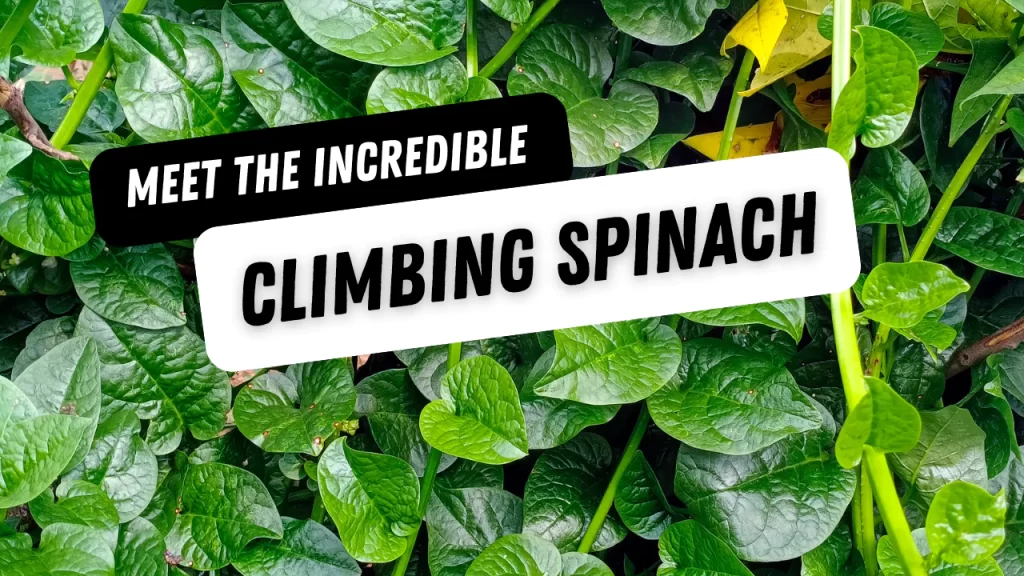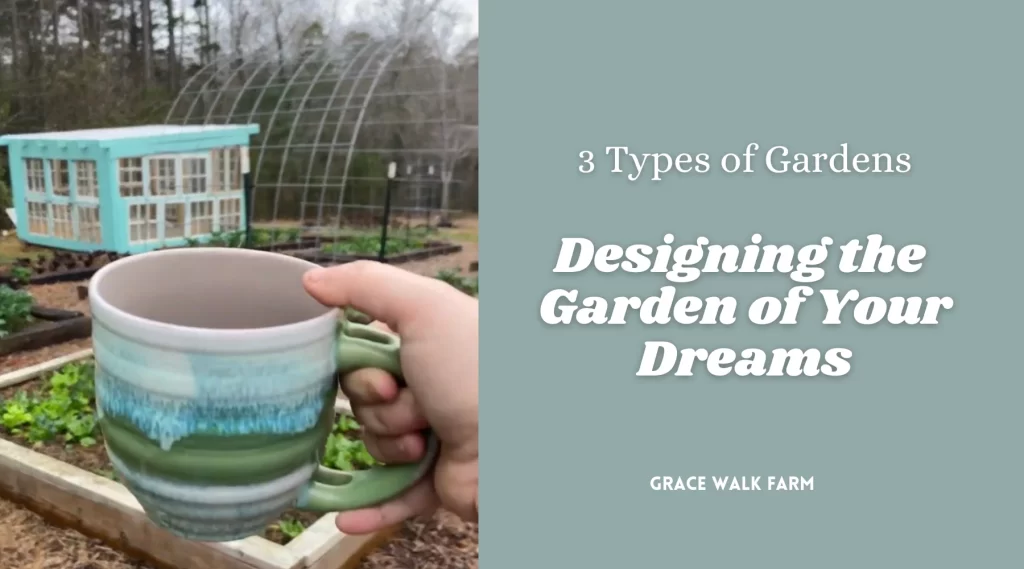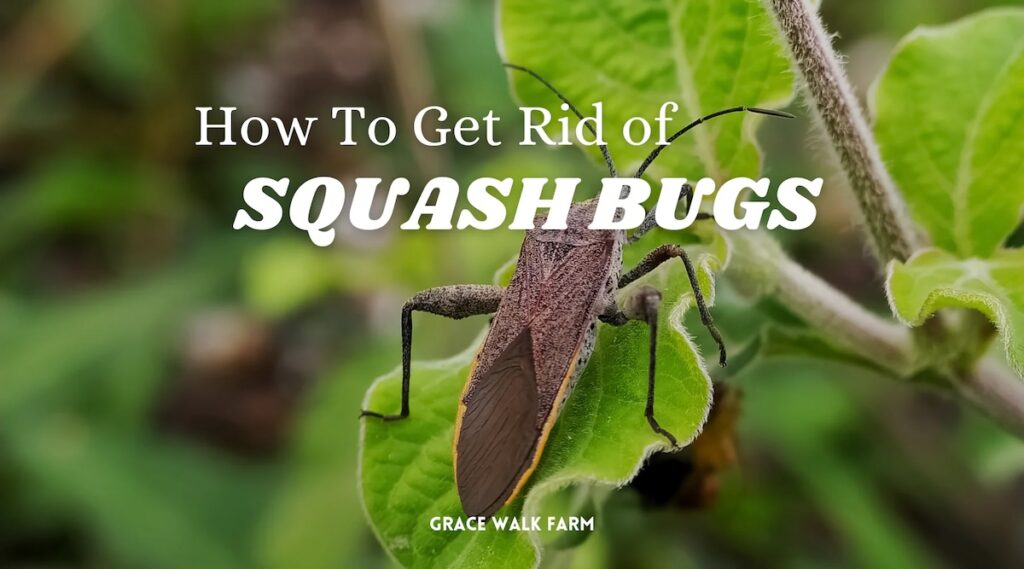So you want to create a backyard garden? If you’re dreaming of a backyard filled with fresh veggies, colorful flowers, and maybe even a few buzzing bees, then you’re already halfway there. Planning a garden can seem overwhelming at first, but with a little guidance, you can set up a thriving garden that suits your space, lifestyle, and time. Whether you’ve got acres to work with or just a few raised beds, I’ll walk you through some tried-and-true steps to help you create a garden that works for you.
Welcome to Grace Walk Farm, our family homestead in western NC. We share the highs and lows of our homestead journey, in hopes that it will encourage you to grow your own food too. Click here to grab our Beginner Garden Guide for free! Join our 600K strong Instagram community of homesteaders here. Thanks for stopping by!
Define Your Backyard Garden’s Purpose
Before you get out your garden trowel, think about what you want to grow and why. Are you hoping for a vegetable garden to supplement your family’s food, or do you dream of a cottage-style flower garden? Do you want herbs close to the kitchen or a dedicated space for pollinator plants to attract bees and butterflies? Knowing your garden’s main purpose will help guide all your decisions, from layout to plant choice.
For instance, if your goal is fresh vegetables, consider starting with easy-to-grow staples like tomatoes, peppers, and lettuce. If it’s a flower garden you’re after, think about color schemes and what blooms will thrive in your climate. And if it’s a mix of both, map out different zones in your garden for specific purposes. This way, you’ll create a space that’s both productive and beautiful.
Assess Your Garden Space and Sunlight
Now that you know what you want to grow, take a good look at your garden space. Walk around at different times of the day and note how much sunlight each area gets. Vegetables like tomatoes and peppers need about 6-8 hours of direct sunlight, while shade-loving plants like lettuce and spinach do better with only a few hours. Observing your garden’s sunlight patterns will help you determine which plants will thrive where.
If your yard doesn’t get a lot of sunlight, don’t worry! You can still grow a fantastic garden with plants that thrive in lower light conditions, like leafy greens and certain herbs. And if you’re working with containers, you can always move them around to capture more sunlight as needed. Knowing your light situation will save you a lot of frustration in the long run!
Choose a Garden Layout
Once you’ve mapped out your sunlight zones, it’s time to choose a layout that works for your space. There are several popular garden layouts to consider, each with its own benefits:
- Raised Beds: Great for small spaces, raised beds allow you to control soil quality and drainage, plus they’re easier on the back!
- Rows: If you have a larger plot, traditional rows are perfect for growing lots of veggies. They make it easy to water and harvest, but do take up more room.
- Square Foot Gardening: Ideal for small spaces, this method involves dividing your garden into square-foot sections, making it super efficient and organized.
- Containers: For those with patios or balconies, containers offer a portable solution and allow you to grow almost anything you would in a garden bed.
Selecting a layout can be one of the most exciting parts of planning, and it’ll help you visualize what’s possible in your space. Remember, there’s no right or wrong way to set up your garden—it’s all about finding what works best for you and your goals.
Plan Your Planting Season
Now that you have an idea of your layout and sunlight, the next step is planning your planting season.
Every region has its own growing season, which is influenced by factors like frost dates and temperature. Understanding your local climate will help you decide when to plant each type of crop for the best harvest.
The simplest way to get started is by finding your USDA Hardiness Zone, which gives you a rough idea of which plants will survive in your area. You can then look up the average last frost date for spring and the first frost date for fall. With this information, you can create a planting calendar.
For example, cool-season crops like lettuce, carrots, and peas can go in the ground as soon as the soil can be worked in early spring. Warm-season plants, such as tomatoes, cucumbers, and peppers, should be planted after the last frost. By planning around these dates, you can make the most of each season, staggering your planting to ensure a continuous harvest.
Prepare Your Soil
Healthy soil is the foundation of a successful garden, so it’s worth taking a little time to prepare it before planting. Start by testing your soil’s pH and nutrient levels, which will tell you if you need to make any adjustments. Most vegetables thrive in slightly acidic to neutral soil (pH 6-7), while some flowers and shrubs prefer different levels. You can pick up an affordable soil testing kit at a garden center or send a sample to a local extension service for a detailed analysis.
Once you know what your soil needs, you can start adding organic matter. Compost is a gardener’s best friend, enriching the soil with nutrients and improving its structure. You can either buy compost or make your own using kitchen scraps, yard waste, and other organic materials. Simply work compost into your soil about a month before planting to give it time to break down and enrich the area.
Adding organic fertilizers, like bone meal or fish emulsion, can also give your garden a great start, providing plants with essential nutrients like nitrogen, phosphorus, and potassium. Preparing your soil now will save you time and give your plants the best possible chance to thrive.
Choose the Right Plants for Your Space and Climate
With so many beautiful plants to choose from, it’s easy to feel overwhelmed when deciding what to grow. But don’t worry, a few guidelines can help you select plants that will thrive in your garden.
First, focus on plants that grow well in your zone. If you’re in a colder region, look for short-season varieties, and if you’re in a warmer climate, you might have the option to grow year-round. Try choosing a mix of annuals (plants that grow for one season) and perennials (plants that return year after year), especially if you want to create a garden with continuous blooms or harvests.
When planning a vegetable garden, think about your family’s eating habits. If you love tomatoes and cucumbers, prioritize those. If you’re excited about trying homemade pesto, basil and garlic should be on your list. By choosing plants you’ll actually use, your garden will become even more rewarding.
Practice Companion Planting for Healthier Plants
Companion planting is a method of growing plants together that benefit each other. This can help you control pests, improve plant health, and even increase your yields. For example, basil is known to repel pests like aphids and mosquitoes, making it a perfect partner for tomatoes. Marigolds are another great companion plant—they deter nematodes and other pests, and their bright blooms add a pop of color to any garden.
Other classic pairs include carrots and onions, which repel each other’s pests, and beans with corn, where beans add nitrogen to the soil that corn needs to grow. Planting companions strategically can make your garden healthier and reduce the need for chemical pest control. Plus, it’s fun to see which plants help each other thrive!
Create a Plan for Watering Your Garden
One of the most important factors in a garden’s success is consistent watering. Plants generally need about an inch of water per week, but this can vary depending on the climate, soil type, and the plants themselves. Setting up a watering plan in advance will save you time and help your garden thrive.
If possible, consider installing a drip irrigation system or soaker hoses, which deliver water directly to the soil, reducing evaporation and preventing foliage from getting wet (which can lead to fungal issues). These systems can be set on timers, so you don’t have to remember to water every day. For container plants, a watering can is ideal, as containers dry out more quickly and need more frequent watering.
Another helpful tip is to water in the early morning or late evening, when temperatures are cooler and water loss from evaporation is minimal. A little planning goes a long way to ensure that every part of your garden stays hydrated.
Maintain Plant Health with Mulch and Weeding
Keeping your garden healthy requires a bit of maintenance, and two essential practices are mulching and weeding. Mulch is a gardener’s secret weapon. A layer of mulch around your plants helps retain moisture, keeps roots cool, and prevents weeds from taking over. Organic mulches, like straw, wood chips, or compost, will eventually break down, adding nutrients to your soil.
Speaking of weeds, they’re inevitable, but with regular care, you can keep them under control. Try to pull weeds when they’re small, as this is when they’re easiest to remove. Hand-pulling is effective, but a hoe can also be helpful for larger areas. By keeping up with weeding and mulching, you’ll create a healthy, low-maintenance environment for your plants.
Plan for Succession Planting
If you want a continuous harvest throughout the growing season, consider practicing succession planting. This means planting crops in stages, so you’ll always have fresh produce coming in. For example, you can plant a row of lettuce every two weeks instead of all at once, ensuring you have a steady supply instead of an overwhelming amount all at once.
Crops like radishes, carrots, and beets can also be planted in succession, allowing you to enjoy fresh vegetables from spring through fall. This approach is especially useful for smaller gardens, where space is limited, as it maximizes every inch of soil.
Rotate Your Crops
If you’re planning a vegetable garden, rotating your crops each year can help prevent soil depletion and reduce the risk of pests and diseases. Crop rotation means changing where you plant each type of vegetable from year to year. This is particularly important for crops that are heavy feeders, like tomatoes, which can quickly drain the soil of nutrients.
A simple way to rotate crops is by dividing your garden into sections for different plant families, such as leafy greens, root vegetables, legumes, and fruiting plants. Each year, shift these groups to a new location within your garden. Crop rotation is a sustainable practice that promotes soil health and helps your plants grow strong and healthy.
Harvest and Enjoy the Fruits of Your Labor
After all the planning and hard work, harvesting is the most rewarding part of gardening! Each plant has its own ideal time for harvesting, so keep an eye on them as they grow. For example, tomatoes should be picked when fully colored and slightly firm, while leafy greens like spinach and lettuce can be harvested as soon as they’re large enough to eat.
When harvesting, be gentle with your plants, and avoid tearing or damaging them. Many plants, such as beans and zucchini, will continue producing if harvested regularly. The more you pick, the more they grow!
Once your bounty is in, enjoy the fruits of your labor in your favorite recipes, share them with neighbors, or even try preserving some of your harvest through canning, drying, or freezing. There’s nothing quite like the satisfaction of eating something you grew yourself, and with a little planning, you’ll have a garden that keeps on giving.
Final Thoughts
Planning a garden might feel like a big project, but by taking it step by step, you’ll find that each part of the process is not only manageable but also enjoyable. A well-planned garden doesn’t just provide fresh food or beautiful flowers; it gives you a chance to connect with the land, reduce your grocery bills, and learn valuable skills along the way. And, most importantly, it’s a source of peace and joy—a place where you can get your hands in the soil and watch life grow.
So, grab your notebook, sketch out your garden space, and dream a little. With some thoughtful planning, your garden can be a reflection of your heart, filled with the plants and flowers that make you happiest. Whether you’re starting with a small container garden or a large vegetable plot, remember that every garden starts with a plan—and there’s no wrong way to begin.
Happy gardening!
Also check out these blogs:




